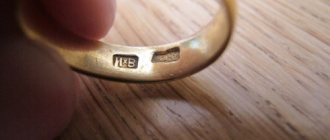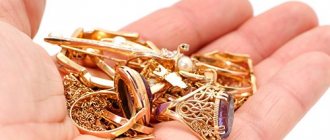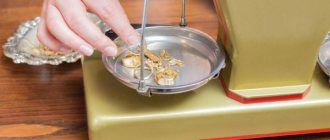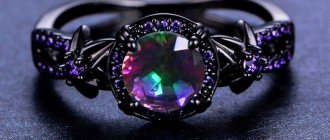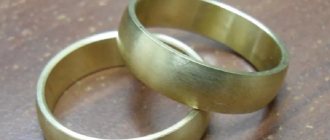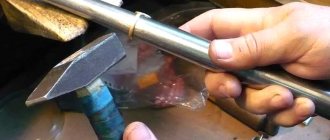It is not always possible to see a sample on gold products, which gives, although not an absolute, guarantee of the authenticity of the noble metal. Some ancient works, as well as jewelry made to order or brought from abroad, do not have a hallmark. They can be made of another metal, similar to gold only in appearance. A consultation with an experienced jeweler will be expensive, and for a small ring, paying for an expert’s work will be commensurate with its cost. There are many ways to test at home if it is really gold. We recommend using one of the simplest methods, using iodine, which can be bought at any pharmacy. How to test gold with iodine? Detailed recommendations in our article.
When does it become necessary to check gold for authenticity?
There are many situations when you have to determine at home whether you see real gold or counterfeit metal before your eyes. Fake gold often looks like natural metal and is an alloy of several elements. For these purposes, brass, aluminum, and iron are used. Alloys used: vermeil, pinchback, butt bronze. Sometimes, it's just well-polished copper. Another option when we can say that a precious metal is not genuine is the use of gold of a lower standard than the declared one.
Along with professional testing methods using special chemical reagents and touchstones, as well as modern analyzer instruments, there are many popular options.
Craftsmen are coming up with more and more new methods of testing noble material for authenticity. There are known identification options using vinegar, a magnet, or a lapis pencil. One of the most reliable, reliable ways: test gold with iodine at home. Explanation for this: iodine is a rare chemical element that can react with such an inert element as gold.
Characteristics of precious metal
Gold is a metal that is resistant to external factors, durable and beautiful, but at the same time very soft. That is why there is no jewelry made from pure precious metal; other chemical elements are necessarily added to the alloy:
- yellow gold - a combination of equal parts of silver, copper and gold itself;
- red gold - 25% copper;
- white gold - contains 32% gold, the rest is an alloy of platinum and nickel.
Pure gold is marked with a purity of 999. The 958 purity contains 96.3% pure gold. Such materials are rarely used for making jewelry - they are very soft.
Necessary tools for iodine testing
A simple technology is used using tools that can be found in any home. To check you will need:
- alcohol solution of iodine, it is sold in different concentrations. The most common option is a 5% iodine solution.
- cotton swab;
- sandpaper;
- high concentration ethyl alcohol;
- a soft cloth such as flannel.
A magnifying glass and tweezers will come in handy if you need to check small details.
Iodine is able to react with gold under normal conditions, causing it to darken at the site of application. Gold iodide is formed - AuI. The dark area will have a different shade. This depends on what standard gold is: 375, 585 or 750. The latter, when combined with iodine, gives a dark green zone, while gold material of 585 standard produces a dark brown tint.
Lack of reaction is a sure sign of a fake.
The procedure for verifying the authenticity of gold with iodine. Step-by-step instruction. Video and photo
Description of the method of how to test gold at home for authenticity using iodine. Testing is easy and safe. The whole procedure takes place in several stages.
Prepare medical iodine and cotton swabs.
Selecting gold jewelry to check
Apply a drop of iodine to the decoration with a cotton swab
Wait a while until it dries
Wipe the stain with a cloth
Treat the product 585 or 583 samples with medical alcohol
At the first stage of preparation, the product is treated with medical alcohol. After processing, allow to dry.
It is recommended to first clean the jewelry with alcohol.
Sand the metal on the inside
The second preparatory stage is carried out using sandpaper. A decoration or simply an object made of gold is sanded on the side that is not the “front”. This is how the ring is processed from the inside. It is necessary to remove the top layer of metal, since it may be covered with a film of external substances. It is necessary to open the gold layer.
In addition to sandpaper, you can use any abrasive material, just not very coarse, so as not to remove too thick a layer of metal and damage the product.
Apply iodine to the jewelry in a wiped area
At the next stage, iodine is applied with a cotton swab. You can use a pipette; with it you can drop a drop exactly onto the area that has been cleaned. It is worth trying to minimize the area on which iodine falls. There will be a reaction on it, a color change will occur.
The reaction does not depend on the size of the spot, so you should not strive to get more reagent onto the surface.
Apply iodine to the cleaned surface of the jewelry
We get the result
Further stages are characterized by observation of the process. A chemical reaction occurs with a substance from the group of halogens, which includes iodine. You can test gold with iodine by its color change. Variations in brown or dark green shades indicate not only that gold is involved in the reaction, iodine indicates a sample.
Greenish tones characterize lower grade metal with a higher copper content.
Removing dirt and nasty stains from gold jewelry
Over time, all gold products fade, become covered with a greasy film and stains, which deteriorates their noble appearance. Therefore, it is worth thinking about how to clean gold from dirt and stains in order to give it its original shine. There are a number of recommendations and tips for quickly and efficiently removing unpleasant plaque or dirt. The main options are:
- To add shine, you should resort to ethyl alcohol, moistening a piece of soft cloth in it.
- If the decoration is not very dirty, then soak it for half an hour in a solution of 1 tbsp. l. washing powder and 1 glass of water. Then rinse thoroughly.
- For jewelry that is heavily soiled, prepare a mixture: 1 ampoule of hydrogen peroxide, 1 ampoule of ammonia, 1 tsp. washing powder and a glass of water. Soak the gold for no more than five minutes and rinse with water.
Checked and cleaned jewelry will delight you with its shine, radiance and beauty.
Other verification tools
Among other means of checking the authenticity of precious metals, there are also several simple options.
Magnet
Checking with a magnet. The property of gold being diamagnetic is used. This is a substance that does not react to a magnetic field. Moreover, pure metal will repel the magnet. Other metals, with the exception of precious metals, have to one degree or another the properties of ferromagnets that experience mutual attraction with a magnet.
Therefore, gold of low purity with additives of other metals can react to a magnet. If the product “sticks” to it, this is a sign of the use of a ferromagnetic alloy with iron, nickel, and other metals.
In this way, you can identify counterfeit jewelry or detect a lower standard at home.
There is the possibility of counterfeits made from materials such as copper and aluminum since they are not magnetic. However, in the presence of a strong magnet, a field arises between it and the copper, which is triggered in such a way that when approaching the metal and almost touching it, the magnet stops abruptly.
Gold in its pure form is not attracted to a magnet
Lapis pencil
A drug based on silver and potassium nitrates is useful for testing gold. To do this, the decoration is lowered under water or part of it is wetted, and a strip is applied to the wet area with a pencil. Then wipe with a dry cloth or cotton pad. The trace left from the lapis indicates that the product is counterfeit.
There will be no stripes left on the gold.
The most common type of lapis pencil
How to check the density of gold in water: table of the density of gold in water according to samples
At home, you can check if the item is truly gold using a measuring cup, water and a kitchen scale.
- Weigh the product. Write down its exact weight.
- Pour water into a measuring cup and immerse the product in it. Note the difference in the volume of water before and after the dive.
- The mass of gold in the product must be equal to the mass of the difference in volume. This ratio should be close to 19 (the density of pure gold is 19.32 g/cm3).
- See the table for the density of gold of different grades in water.
Table of density of gold in water according to samples.
Convenience of the method and its disadvantages
A household method of checking precious metal for authenticity using iodine:
Convenient and easy enough to use.
Does not require complex chemical reagents or special equipment.
It can be carried out by non-specialists; it is enough to carefully observe the reaction of the interaction of two elements.
The disadvantages include:
Checking only the surface part of the jewelry.
It is impossible to obtain a result with 100% accuracy.
It is impossible to check gold-plated products; the top layer of gold will be removed with sandpaper.
Difficulties also arise with rhodium-plated products, if a thin layer of rhodium is removed, a yellowish or reddish metal appears underneath it.
Jeweler services as a reliable and safe way to verify the authenticity of metal
Traditional methods of metal testing are good as an express method. For reliability and confidence in the results, you should contact a professional jeweler. In his arsenal there will be all the necessary means of determining the authenticity of a gold product.
The jeweler always has the necessary tools at hand to test precious metals.
Visual inspection
Visual inspection boils down to checking the markings of the gold product. You need to find a sample and a distinctive sign of the manufacturer. The original product has all the details, the numbers are easy to read, and the stamping depth is the same. The size is barely readable.
At the top is a fake, at the bottom is a real gold ring.
Large numbers, the absence of a manufacturer's mark, and different depths of numbers should alert you. It is better to refuse such jewelry and not make a purchase.
